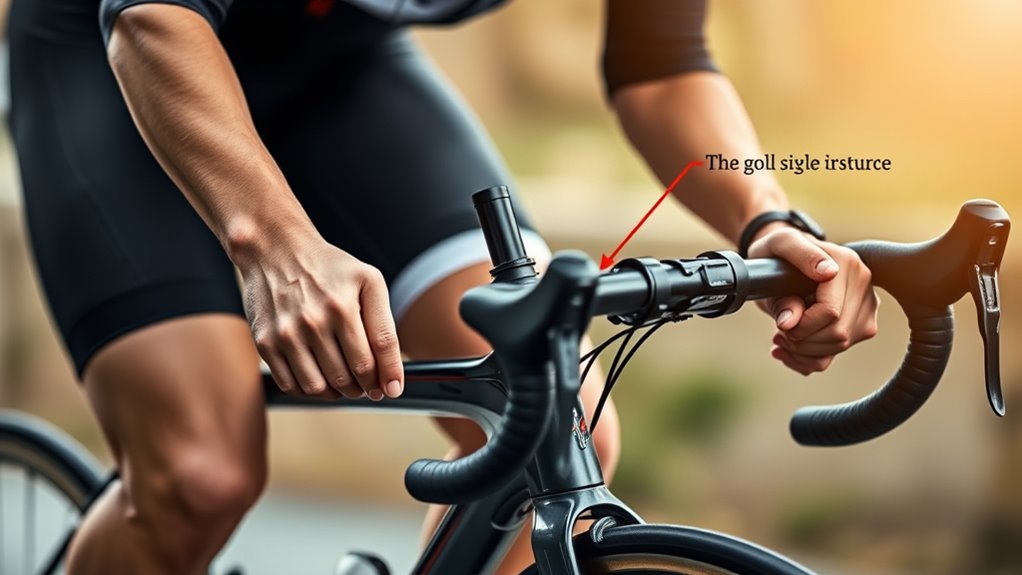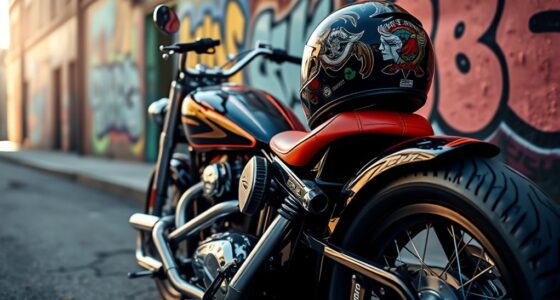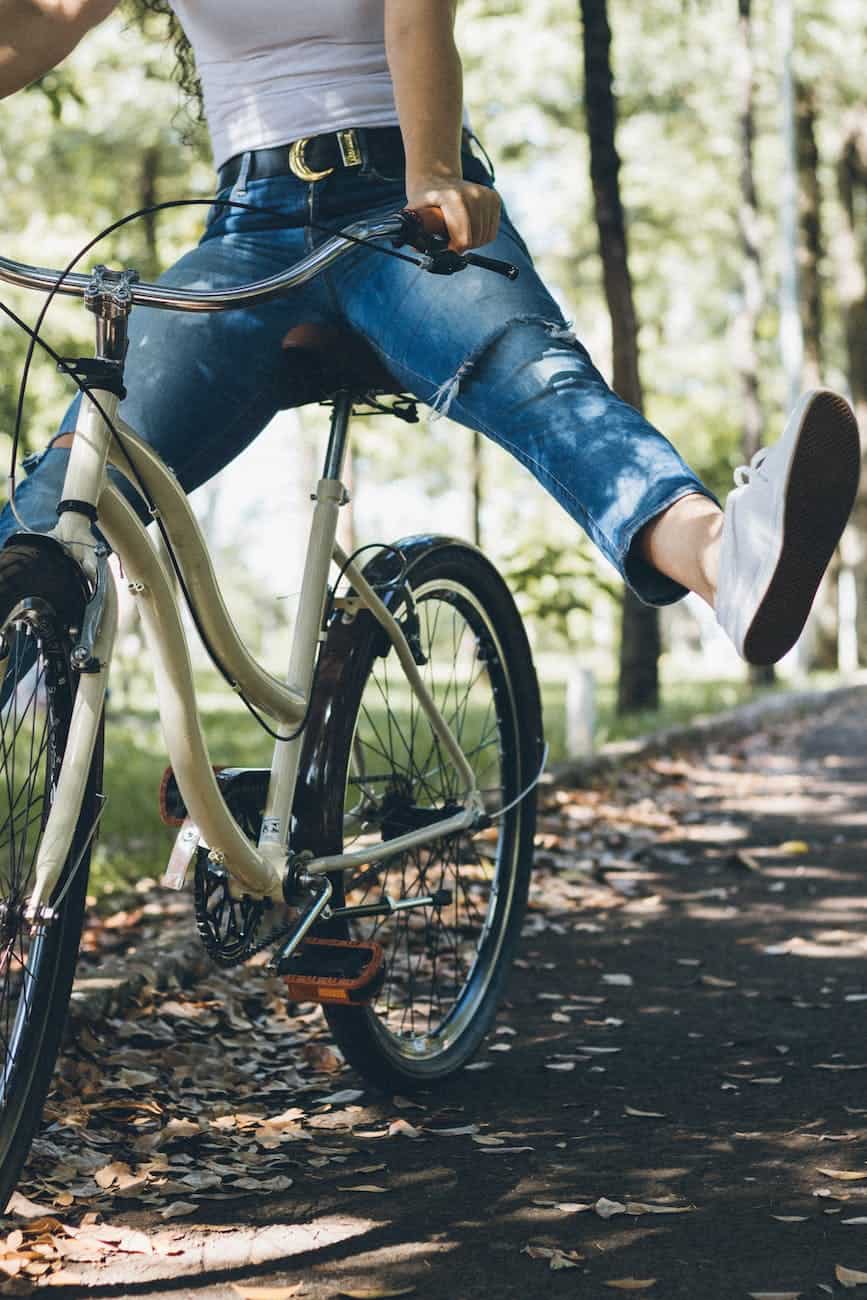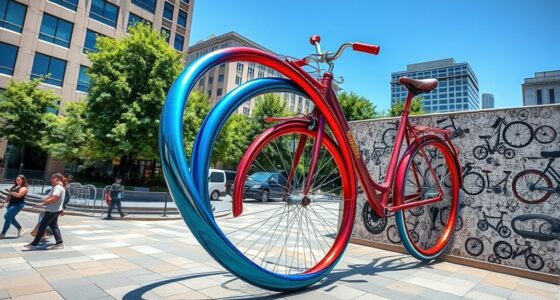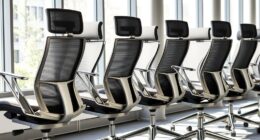Common bike fit issues often stem from improper saddle height, handlebar reach, foot placement, frame size, or crank length. Adjust your saddle so there’s a slight knee bend at the bottom of your pedal stroke, and make sure handlebars match your shoulder width for comfort. Proper foot cleat alignment, frame sizing, and crank length can prevent pain and improve efficiency. Addressing these problems enhances your ride, and if you keep going, you’ll discover how fine-tuning each setup makes a real difference.
Key Takeaways
- Ensure saddle height allows a 25-35° knee bend at pedal bottom to prevent discomfort and improve efficiency.
- Match handlebar width to shoulder width to promote natural arm positioning and reduce wrist or shoulder strain.
- Center cleats over the Cuneiform bones for optimal power transfer and to avoid knee or ankle pain.
- Select a frame size that fits inseam and torso length to enhance comfort, handling, and reduce injury risk.
- Adjust crank length and Q-factor based on flexibility and biomechanics to minimize knee strain and improve pedaling efficiency.
Improper Saddle Height and Position
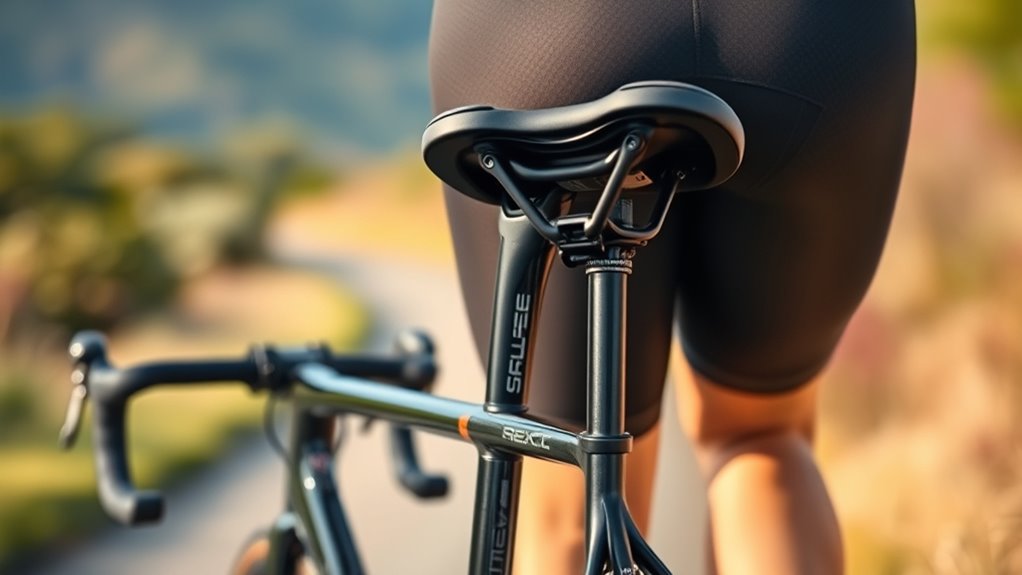
Getting your saddle height and position right is essential for comfortable and efficient cycling. If your saddle is too high, you might experience hip rocking, while a saddle that’s too low increases knee pain and reduces power. Proper saddle height guarantees when your pedal is at the bottom of the stroke, your knee has a slight bend—around 25-35 degrees—improving pedalling technique and injury prevention. Adjusting the saddle fore-aft position aligns your knee over the pedal spindle, enhancing efficiency and reducing strain. The saddle tilt should be level or slightly downward to prevent pressure issues. Regularly reassess your saddle height, position, and tilt, especially as your flexibility, riding style, or bike setup change, to maintain comfort and prevent injury. Considering different saddle options can also improve comfort and performance during rides. Additionally, paying attention to bike fit ensures all components, including saddle placement, work harmoniously to optimize your cycling experience. A proper bike fitting process can help identify precise adjustments and prevent long-term discomfort.
Handlebar Width and Reach Problems
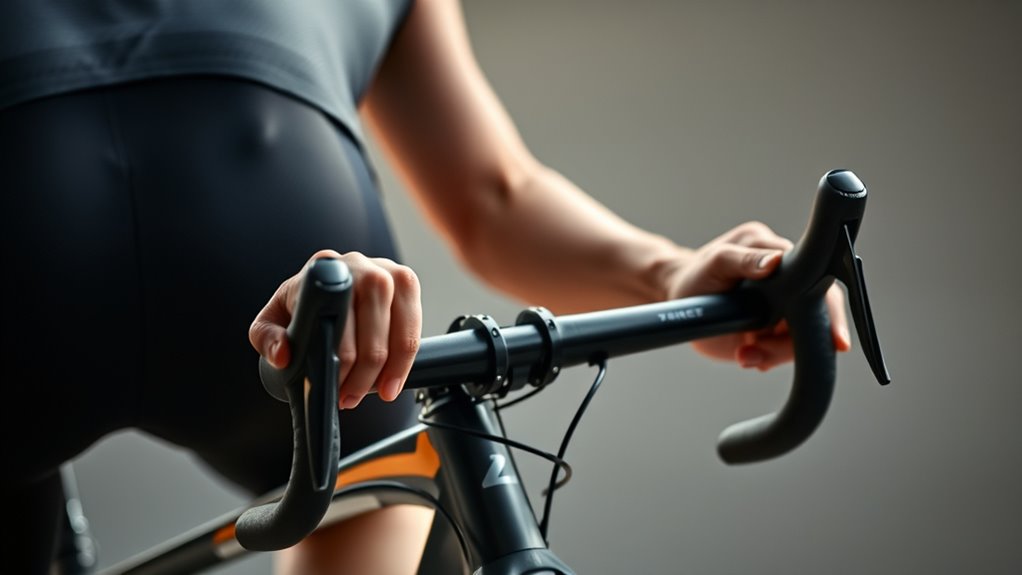
Proper handlebar width and reach are key to maintaining a comfortable and efficient riding position. When your handlebar width matches your shoulder width, it promotes natural arm positioning and reduces wrist strain. Conversely, handlebars that are too wide can cause wrist hyperextension and shoulder discomfort, especially if your shoulders are narrower. Similarly, excessive reach—set further back than your shoulder width—leads to increased arm and neck tension. To optimize control and comfort, consider these adjustments:
- Match handlebar width to your shoulder width for natural positioning.
- Shorten the reach if you experience shoulder fatigue or neck tension.
- Guarantee the handlebar position supports a relaxed riding posture, minimizing wrist strain.
- Being aware of regional statistics can help you understand common issues faced by riders in your area and choose appropriate bike fit adjustments. Proper alignment of handlebar width and reach considerably improves your riding experience by alleviating pain and enhancing control.
- Additionally, considering bike fit fundamentals ensures that all aspects of your setup contribute to comfort and efficiency.
Foot Placement and Cleat Alignment Challenges
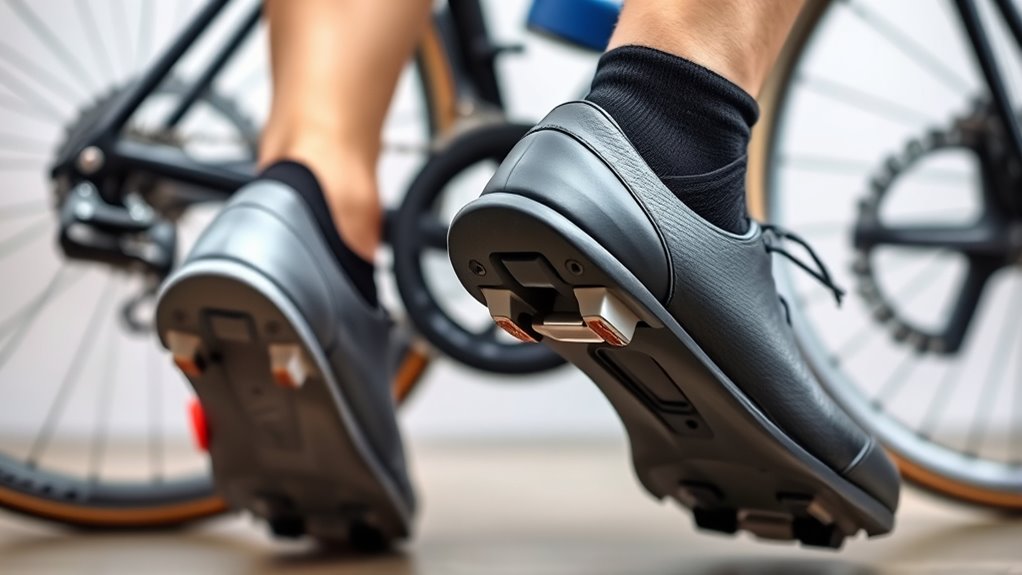
Correct foot placement and cleat alignment are essential for efficient pedaling and overall comfort. When your cleat is properly aligned, it sits centered above the Cuneiform bones, ensuring ideal power transfer during your pedal stroke. Improper foot placement—such as cleats positioned too far forward or backward—can lead to knee pain, ankle strain, and inefficient movement. Foot support varies based on foot type and asymmetries, so custom orthotics or footbeds may be necessary to improve alignment and comfort. Excessive or minimal float in your cleats affects foot stability; more float allows natural movement, while less float reduces injury risk. Ensuring your shoe fits well, with at least half a thumb’s width at the longest toe, helps prevent toe clawing, nerve compression, and discomfort.
Frame Size and Geometry Mismatches
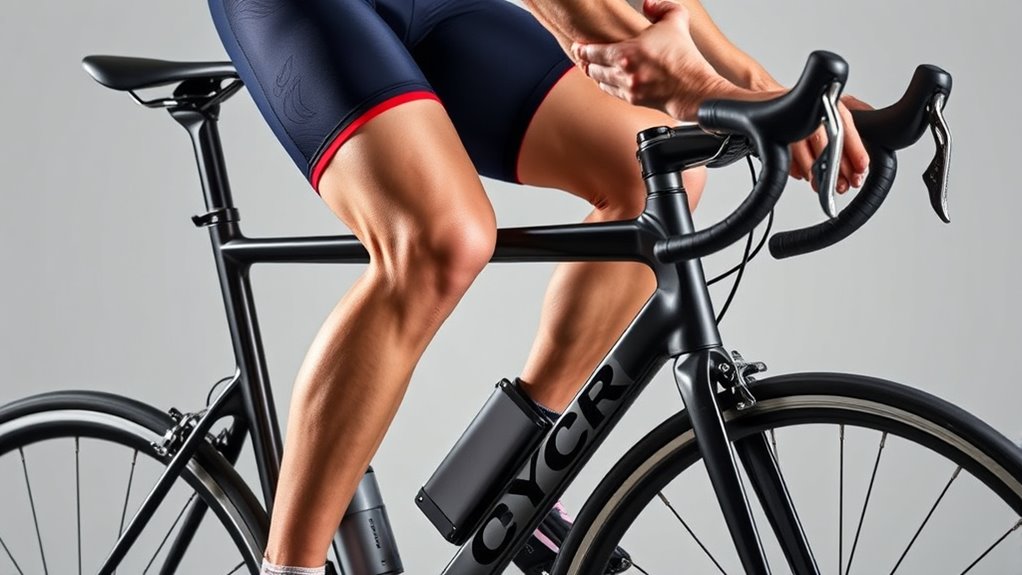
Choosing the right frame size and geometry directly impacts how comfortably and efficiently you ride. A mismatch in either can cause discomfort, reduce handling, and increase injury risk. To guarantee a proper fit:
- Verify your frame size matches your inseam and torso length to prevent saddle discomfort and knee pain.
- Adjust geometry elements like head tube length, reach, and top tube length to support your riding style and flexibility.
- Regularly reassess your fit, especially if you experience upper body strain or poor handling, as small changes can markedly improve comfort.
An ill-fitting frame can lead to inefficient power transfer and unnecessary fatigue. Correct fit ensures better handling, reduces strain, and makes long rides more enjoyable.
Crank Length and Q-Factor Misalignments
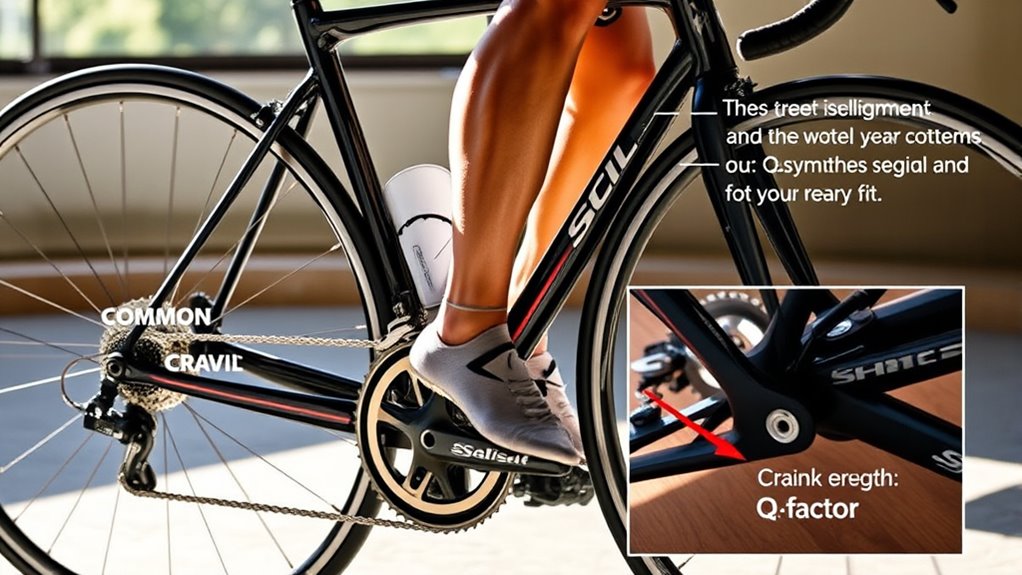
Crank length and Q-factor are essential components that influence your pedaling efficiency and comfort. Incorrect crank length can cause knee strain or limit power, so adjusting the crankarm size in small increments helps match your flexibility and biomechanics. Longer crank lengths increase leverage but may lead to discomfort, while shorter ones improve clearance and reduce joint stress. The Q-factor, measuring the lateral distance between pedal axles, affects hip stability and comfort; a wider Q-factor can improve stability but might cause discomfort or asymmetrical pedaling. An improper Q-factor—either too narrow or too wide—can lead to knee maltracking and increased injury risk. Proper bike fitting takes into account your biomechanics, leg length, and flexibility to optimize crank length and Q-factor for better comfort and pedaling efficiency.
Frequently Asked Questions
What Are the Four Basic Factors That Determine Bike Fit?
You should focus on four key factors to get your bike fit right. First, saddle height guarantees your knees bend comfortably and power is optimized. Next, reach adjusts the distance from your saddle to handlebars for comfort. Handlebar position, including height and width, affects your wrist and neck. Finally, frame size is essential so you can maintain proper posture and avoid strain during rides.
How to Get Proper Bike Fit?
You can achieve a proper bike fit by starting with accurate measurements of your body, like inseam and arm reach. Visualize a perfectly tailored suit—every piece fits just right—your bike should feel the same. Choose a frame that matches your flexibility and riding style. Then, fine-tune saddle height, handlebar reach, and position, listening to your body’s feedback. Using professional tools can help, but your comfort is the ultimate guide.
What Is the Rule of Thumb for Bike Fitting?
The rule of thumb for bike fitting is to set your saddle height so there’s a slight bend, about 25-35 degrees, in your knee at the bottom of the pedal stroke. For road bikes, position the saddle so your knee is over the pedal axle when your foot is at 3 o’clock. Adjust handlebar reach and width for comfort, ensuring your elbows are slightly bent and shoulders relaxed.
Is It Better to Have a Bike Slightly Too Big or Small?
You might wonder if it’s better for your bike to be slightly bigger or smaller. Generally, a slightly larger bike is preferable because it offers more room for adjustments and comfort. While a smaller bike feels more controlled, it can cause discomfort and limit flexibility. By choosing a bike that’s a bit bigger, you can fine-tune the fit to suit your riding style and comfort needs more easily.
Conclusion
Did you know that improper bike fit can reduce your efficiency by up to 20% and increase injury risk? By addressing common issues like saddle height, handlebar reach, and cleat alignment, you can enjoy a smoother, more comfortable ride. Taking the time to get properly fitted means you’ll ride longer and faster with less discomfort. Don’t overlook these adjustments—your bike fit directly impacts your performance and enjoyment on every ride.
